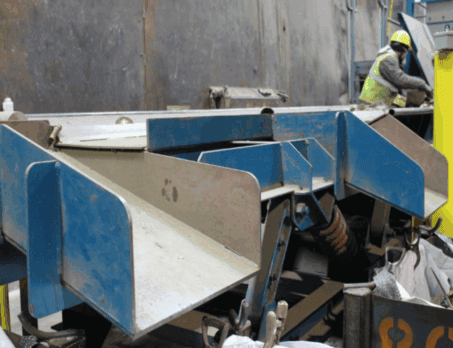What Are Vibratory Inclined Conveyors?
Vibratory inclined conveyors are a cost-effective way to transport castings, scrap, sand, and other materials from one level of a facility to another. They are used in foundries that want to increase production volume without expanding or completely rebuilding their facility. Foundries benefit from vibrating inclined conveyors because they integrate seamlessly into existing layouts, are energy efficient, and can reduce manual labor. They generally operate on an incline angle of 10-19 degrees.
How Vibratory Incline Conveyors Work
These conveyors vibrate with a positive forward motion. The momentum from the vibrations moves materials forward and upward. Rocker legs and springs help with the movement, increasing the material’s movement by as much as 6 degrees.
Moving materials upwards on an incline using vibrations sounds counterintuitive. However, inclined vibratory conveyors, such as GK’s V-TROUGH®, are engineered with special ‘grids’ to capture materials moving upwards. The vibrations move the castings, causing them to ‘bounce’ into the ascending grids of the conveyor and continue conveying upwards. For some applications, a rubber belt liner is put at the bottom to better grip the castings.
Benefits of Vibratory Inclined Conveyors
For foundries specifically, vibratory inclined conveyors have several benefits, including, but not limited to:
- Efficiency: Providing a steady, controlled material flow upwards or downwards, even with materials that are less uniform in size, like complex castings.
- Energy Savings: Vibratory inclined conveyors require less energy than inclined belt conveyors, thanks to the vibratory motion.
- Reduced Footprint: The incline allows these conveyors to go over other foundry equipment or transport materials to different levels, making it easier to process more materials in the same space.
- Turnkey Integration: Easily integrated into existing production lines or manufacturing systems.
Applications
While inclined belt conveyors are used for aggregate, food, and package sorting, vibratory inclined conveyors are often used for specialized industrial applications, such as in foundries, die casting facilities, ASR processing, and wood handling.
V-TROUGH® Vibratory Conveyors vs. Belt Conveyors in Die Casting Applications
The V-Trough® was explicitly designed to handle rough scrap metal in die casting applications. When transported, scrap metal can tear belts on traditional belt conveyors. Since the V-Trough® is built using a ‘V’ shape and has a small rubber belt between each trough section, it is significantly easier to maintain.
With traditional belt conveyors, you’d need to replace the entire belt if part of it tore. With the V-Trough®, only the torn section needs to be changed out. This provides a longer wear life compared to traditional belt conveyors.
V-TROUGH®: Die Casting Application in Action
A GK foundry customer needed to move sprue up an incline to feed their scrap bay. However, they regularly run fork trucks underneath the scrap bay, so they couldn’t install a standard horizontal vibratory conveyor in that spot. GK’s V-TROUGH® was ideal for the situation due to its long wear life and ability to operate at an incline, ensuring the foundry ran efficiently.
Want to learn more about inclined vibratory conveyors and how they can improve your die casting scrap and material handling operations? Contact our experts, and we’ll help you reduce maintenance and increase efficiency in your foundry!






